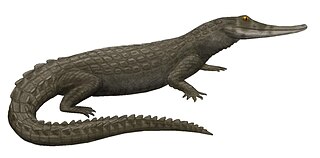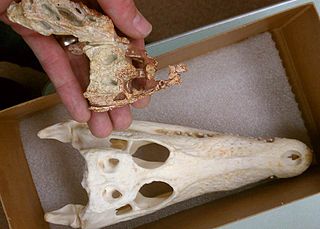
Sauroposeidon is a genus of sauropod dinosaur known from several incomplete specimens including a bone bed and fossilized trackways that have been found in the U.S. states of Oklahoma, Wyoming, and Texas.

Tenontosaurus is a genus of medium- to large-sized ornithopod dinosaur. It was a relatively medium sized ornithopod, reaching 6 to 7 meters in length and 600 to 1,000 kilograms in body mass. It had an unusually long, broad tail, which like its back was stiffened with a network of bony tendons.

Astrodon is a genus of large herbivorous sauropod dinosaur, measuring 20 m (66 ft) in length, 9 m (30 ft) in height and 20 metric tons in body mass. It lived in what is now the eastern United States during the Early Cretaceous period, and fossils have been found in the Arundel Formation, which has been dated through palynomorphs to the Albian about 112 to 110 million years ago.

The Glen Rose Formation is a shallow marine to shoreline geological formation from the lower Cretaceous period exposed over a large area from South Central to North Central Texas. The formation is most widely known for the dinosaur footprints and trackways found in the Dinosaur Valley State Park near the town of Glen Rose, Texas, southwest of Fort Worth and at other localities in Central Texas.
The Twin Mountains Formation, also known as the Twin Mak Formation, is a sedimentary rock formation, within the Trinity Group, found in Texas of the United States of America. It is a terrestrial formation of Aptian age, and is notable for its dinosaur fossils. Dinosaurs from this formation include the large theropod Acrocanthosaurus, the sauropod Sauroposeidon, as well as the ornithopods Tenontosaurus and Convolosaurus. It is the lowermost unit of the lower Cretaceous, lying unconformably on Carboniferous strata. It is overlain by the Glen Rose Formation. It is the lateral equivalent of the lower part of the Antlers Formation.
Pachycheilosuchus is an extinct genus of neosuchian from the Early Cretaceous of Texas, United States. Previously known, in part, as the "Glen Rose form", this crocodylomorph is notable for its procoelous vertebrae, otherwise found only in derived eusuchian crocodilians, a thick margin on the maxillae, and a shield of armor on the neck formed by the fusion of six individual scutes.
Rugosuchus is an extinct genus of neosuchian crocodyliform from the late Early Cretaceous of China. It is known from most of a skull, a partial postcranial skeleton, and a second partial skeleton including part of the hips. It was described by Xiao-Chun Wu and colleagues in 2001, with R. nonganensis as the type species. At the time of its description, it was the most complete crocodyliform from northeastern China, and only the second known.

Neosuchia is a clade within Mesoeucrocodylia that includes all modern extant crocodilians and their closest fossil relatives. It is defined as the most inclusive clade containing all crocodylomorphs more closely related to Crocodylus niloticus than to Notosuchus terrestris. Members of Neosuchia generally share a crocodilian-like bodyform adapted to freshwater aquatic life, as opposed to the terrestrial habits of more basal crocodylomorph groups. The earliest neosuchian is suggested to be the Early Jurassic Calsoyasuchus, which lived during the Sinemurian and Pliensbachian stages in North America. It is often identified as a member of Goniopholididae, though this is disputed, and the taxon may lie outside Neosuchia, which places the earliest records of the group in the Middle Jurassic.
Gilchristosuchus is an extinct genus of neosuchian crocodyliform. Its fossils have been found in the upper Milk River Formation of Alberta, Canada, in rocks of either latest Santonian or earliest Campanian age. Gilchristosuchus was described in 1993 by Wu and Brinkman. The type species is G. palatinus, in reference to its distinctive palatine bones.
Eopneumatosuchus is an extinct genus of basal crocodyliform. Fossils have been found from two localities within the Kayenta Formation of Arizona. Both localities are around 20 miles southeast of the Grand Canyon and in close proximity to one another. The localities probably date back to the Early Jurassic, most likely during the Sinemurian stage.

Isisfordia is an extinct genus of crocodyliform closely related to crocodilians that lived in Australia during the Middle Cretaceous (Albian–Cenomanian).

Paralligatoridae is an extinct family of neosuchian crocodyliforms that existed during the Jurassic and Cretaceous periods. It includes the genera Paralligator, Brillanceausuchus, Kansajsuchus, Shamosuchus, Scolomastax, Sabresuchus, Rugosuchus, Batrachomimus and Wannchampsus, as well as the yet-unnamed "Glen Rose form".
Sunosuchus is an extinct genus of goniopholidid mesoeucrocodylian. Fossils are known from China, Kyrgyzstan, and Thailand and are Jurassic in age, although some may be Early Cretaceous. Four species are currently assigned to the genus: the type species S. miaoi and the species S. junggarensis, S. shartegensis, and S. shunanensis. All species are from China. Goniopholis phuwiangensis, also from Thailand, was reassigned to Sunosuchus by Andrade et al. (2011). The material from Kyrgyzstan has not been assigned to any species.

Susisuchus is an extinct genus of neosuchian mesoeucrocodylian crocodyliform from the Early Cretaceous of Brazil. Fossils have been found from the Nova Olinda Member of the Aptian-age Crato Formation in the Araripe and Lima Campos Basins of northeastern Brazil. Named in 2003, Susisuchus is the sole member of the family Susisuchidae, and is closely related to the clade Eusuchia, which includes living crocodilians. The type species is S. anatoceps, known from a single partial articulated skeleton that preserves some soft tissue. A second species, S. jaguaribensis, was named in 2009 from fragmentary remains.
Hulkepholis is an extinct genus of goniopholidid mesoeucrocodylian from the Early Cretaceous of southern England and eastern Spain. It contains two species, the type species, Hulkepholis willetti, and also H. plotos. Hulkepholis is most closely related to both species of Anteophthalmosuchus.

Coelognathosuchia is an extinct clade of neosuchian crocodyliforms that includes all taxa more closely related to the family Pholidosauridae than to Bernissartia fagesii or Eusuchia. Martin et al. (2014) named the clade after finding goniopholidids and pholidosaurids to group together in their phylogenetic analysis of crocodyliform evolutionary relationships. In their analysis, Pholidosauridae was monophyletic and Goniopholididae was paraphyletic, being an assemblage of successively more basal taxa within Coelognathosuchia. Coelognathosuchia itself was positioned near the base of the larger clade Neosuchia as the sister group to a clade containing the Early Cretaceous neosuchian Bernissartia and Eusuchia, the group that includes all modern crocodilians and their closest extinct relatives.

The Trinity Group is a group in the Lower Cretaceous lithostratigraphy of Texas, Arkansas, Mississippi, Louisiana and Oklahoma. It is named for the Trinity River of Texas.

Wannchampsus is an extinct genus of paralligatorid neosuchian, close to but not a true crocodilian. It is known from fossils discovered in Lower Cretaceous rocks in north-central Texas, United States.
Deltasuchus is a genus of neosuchian crocodyliform from the Late Cretaceous of Texas, specifically in the Woodbine Formation, which was a part of the Appalachian continent during the Cretaceous. It is known from one species, D. motherali, named in 2017 by Thomas Adams, Christopher Noto, and Stephanie Drumheller. It was a large crocodyliform with an estimated total body length of 5.6–6 metres (18–20 ft). In 2021, new material was described, allowing Deltasuchus to be placed within the family Paluxysuchidae as the sister taxon to Paluxysuchus.
Titanochampsa is a genus of large mesoeucrocodylian from the Maastrichtian Marilia Formation of Brazil. Although only known from a single skull roof, the material shows that Titanochampsa was not a member of Notosuchia, which were previously believed to have been the only crocodyliforms present in the strata of the Bauru Group. Body size estimates vary greatly and range between 2.98–5.88 m due to the incomplete nature of the holotype fossil. The overall anatomy of the skull roof, alongside its size and possible affinities with Neosuchians, may suggest that it was a semi-aquatic ambush hunter similar to modern crocodilians.












